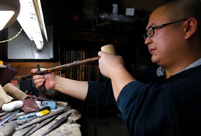 'Jin' named the word of the year by cross-strait netizens
'Jin' named the word of the year by cross-strait netizens Chinese scientific expedition goes to build new Antarctica station
Chinese scientific expedition goes to build new Antarctica station
 Chinese naval escort fleet conducts replenishment in Indian Ocean
Chinese naval escort fleet conducts replenishment in Indian Ocean 17th joint patrol of Mekong River to start
17th joint patrol of Mekong River to start China's moon rover, lander photograph each other
China's moon rover, lander photograph each other Teaming up against polluters
Teaming up against polluters
 |
| Workshop of foreign affairs experts is convened in Beijing to discuss the survey results and their implications for China-U.S. relations. (CarnegieEndowment.org/pubs) |
How do Chinese and American people view each other? After a year’s preparation and research, the U.S.-China Securities Perceptions Survey: Findings and Implications is now complete. A joint effort by the China Strategic Culture Promotion Association and the Carnegie Endowment for International Peace, the report is dedicated to identify the stable elements that exert influence on the strategic decision-making of China and U.S, as well as the interactions of national strategies and public opinions.
1.Some survey data are not directly comparable
This project involved two phases in both the United States and China. During the first phase, opinion surveys were conducted in both countries across the general public and an elite, and the questionnaires were the same. Influential opinion was canvassed from five distinct categories—government, business, academia, the military, and the media. During the second phase, workshops of foreign affairs experts with backgrounds in these same five categories were convened in Beijing and Washington to discuss the survey results and their implications for China-U.S. relations.
According to the report, the “military” categories in the Chinese and U.S. survey data are unlikely to be directly comparable. The military category in the Chinese data included only military academics, not operational military personnel or retired officers. These military academics do not necessarily represent the views of the broader People’s Liberation Army on many issues. The military category in the American survey, in contrast, was composed of retired U.S. military officers.
The “government officials” categories are likewise not directly comparable. In the Chinese data, the government officials were primarily officials at provincial and municipal level. The survey did not include a large sampling of central government officials. Moreover, most of these officials were retired. Meanwhile, in the United States, the government officials were all current government officials at the national level—mostly from the executive branch, with some from the legislative branch.
2.Enemy or Partner?
In general, very low percentages of all the Chinese and U.S. categories viewed the other country as an enemy. Roughly equal percentages of each country’s public regarded the other country as an enemy (12 percent in China and 15 percent in the United States). And only 2 percent of U.S. political representatives regarded China as an enemy.
Strong majorities in all categories in the U.S. viewed China as a competitor, while substantial minorities (16 percent of the U.S. public and a range of between 13 percent and 22 percent of the U.S. elite, depending on the category of respondents) viewed China as a partner. 45 percent of the Chinese public viewed U.S. as a competitor, and strong majorities of the Chinese elite in all categories viewed the U.S. as a competitor.
Young Americans expressed higher levels of trust in China than older Americans. Some suggested that younger generations in general tend to be more trusting and open and that this was probably true historically as well. In addition, older generations today have had very different life experiences, such as living through the Vietnam and Korean Wars, which could shape their views on China.
A Chinese scholar proposed that in addition to differences in ideology and political system, America’s military deployment and the “siege” it imposes on China also contribute to Chinese people’s low trust in the U.S.

 People prepare for upcoming 'Chunyun'
People prepare for upcoming 'Chunyun'  Highlights of Beijing int'l luxury show
Highlights of Beijing int'l luxury show Record of Chinese expressions in 2013
Record of Chinese expressions in 2013 China's moon rover, lander photograph each other
China's moon rover, lander photograph each other 17th joint patrol of Mekong River to start
17th joint patrol of Mekong River to start Spring City Kunming witnesses snowfall
Spring City Kunming witnesses snowfall Heritage of Jinghu, arts of strings
Heritage of Jinghu, arts of strings Weekly Sports Photos
Weekly Sports Photos PLA elite units unveiled
PLA elite units unveiled  China's stealth fighters hold drill over plateau
China's stealth fighters hold drill over plateau Chinese navy hospital ship's mission
Chinese navy hospital ship's mission  "Free lunch" program initiated in NW China
"Free lunch" program initiated in NW China  Rime scenery in Mount Huangshan
Rime scenery in Mount Huangshan DPRK's Kaesong Industrial Complex
DPRK's Kaesong Industrial Complex 'Jin' named the word of the year
'Jin' named the word of the year Day|Week|Month